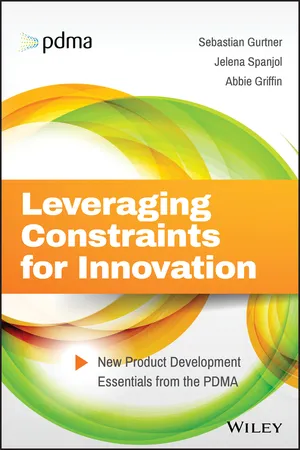
Leveraging Constraints for Innovation
New Product Development Essentials from the PDMA
- English
- ePUB (mobile friendly)
- Available on iOS & Android
Leveraging Constraints for Innovation
New Product Development Essentials from the PDMA
About this book
Provides managers with actionable insight into a select set of innovation constraints and how to best deal with them
This PDMA Essentials Book, the third in this series, provides a framework of individual, organizational, and market and societal constraints that guides managers in identifying specific constraints related to their innovation activities and provides them with corresponding tools and practices to overcome and leverage those constraints.
Written by a team of international innovation experts, Leveraging Constraints for Innovation: New Product Development Essentials from the PDMA is presented in three parts. The first part, Individual Constraints, provides insights into how to: simultaneously solve social and commercial needs for greater creativity; apply a multi-stage approach to overcome knowledge sharing in teams; and anticipate and account for psychographic differences among customers during product launch. In the second part, Organizational Constraints, insights emerge that provide guidance on how to: identify and solve for sources of innovation constraints within the company; implement and manage virtual NPD teams; and effectively organize new service development in professional services. The last part, Market Constraints, examines how to: adapt firm capabilities to overcome constraints preventing consumers in low-end and under-resourced markets from purchasing new products; implement inclusive innovation strategies to address markets constrained by underdeveloped infrastructures; develop solutions for women and other disadvantaged market traders in emerging markets.
This book:
- Is a single comprehensive volume that covers the full spectrum of constraint-related strategies and techniques in a coherent, integrated fashion
- Provides a set of frameworks, techniques, and tools that can be immediately implemented by individuals across firms
- Offers how-to knowledge on specific tools and methods as applied to innovating products and services when facing constraints as well as for the development of new business models
- Integrates problem- and solution-based knowledge to enable companies to develop sustainable growth strategies by leveraging constraints and restrictions toward innovation strategies, processes and offerings
Leveraging Constraints for Innovation: New Product Development Essentials from the PDMA is an ideal book for all product development professionals, including marketers, engineers, project managers, and business managers in both startups and well-established firms, and from a broad range of industries from heavy manufacturing to the service sector.
Frequently asked questions
- Essential is ideal for learners and professionals who enjoy exploring a wide range of subjects. Access the Essential Library with 800,000+ trusted titles and best-sellers across business, personal growth, and the humanities. Includes unlimited reading time and Standard Read Aloud voice.
- Complete: Perfect for advanced learners and researchers needing full, unrestricted access. Unlock 1.4M+ books across hundreds of subjects, including academic and specialized titles. The Complete Plan also includes advanced features like Premium Read Aloud and Research Assistant.
Please note we cannot support devices running on iOS 13 and Android 7 or earlier. Learn more about using the app.
Information
Part 1
INDIVIDUAL CONSTRAINTS IN NEW PRODUCT DEVELOPMENT

1
FROM SUSTAINABILITY CONSTRAINTS TO CREATIVE ACTION: INCREASING MANAGERIAL INNOVATION BY SIMULTANEOUSLY SOLVING SOCIAL AND COMMERCIAL NEEDS
McMaster University, Hamilton, ON, Canada
Maryam Ghasemaghaei
McMaster University, Hamilton, ON, Canada
Introduction: From Constraints to Innovation
1.1 The Inherent Uncertainty of the Innovation Process
Table of contents
- COVER
- ABOUT THE EDITORS
- INTRODUCTION
- Part 1: INDIVIDUAL CONSTRAINTS IN NEW PRODUCT DEVELOPMENT
- Part 2: ORGANIZATIONAL CONSTRAINTS
- Part 3: MARKET CONSTRAINTS
- INDEX
- END USER LICENSE AGREEMENT